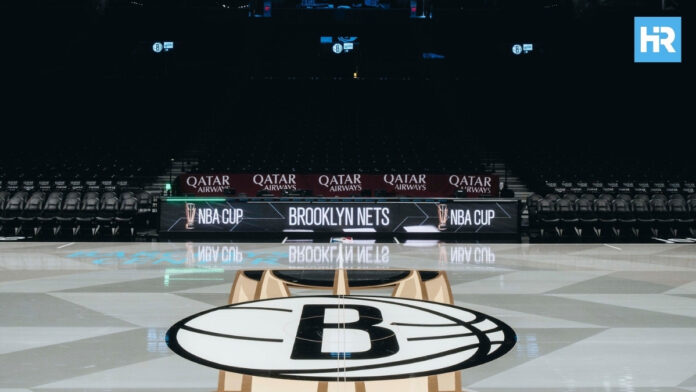The Brooklyn Nets franchise has moved through multiple names, arenas, states, and eras since it was founded. It began as the New Jersey Americans in the ABA (American Basketball Association), became the New York Nets, then the New Jersey Nets in the NBA, and now plays as the Brooklyn Nets in the Atlantic Division of the Eastern Conference at Barclays Center in Brooklyn, New York.
Today, we’ll explore the team’s full journey: its relocations across states, rebrands, the evolution of the Brooklyn Nets logo and colors, and the exact timeline of when and why the Nets moved to Brooklyn.
Quick Timeline of the Nets Franchise
- 1967: Founded as the New Jersey Americans in the ABA.
- 1968–1976: Became the New York Nets, bouncing around arenas on Long Island.
- 1974 & 1976: Won two ABA championships behind Julius “Dr. J” Erving.
- 1976: Joined the NBA in the ABA–NBA merger.
- 1977–2012: Relocated and rebranded as the New Jersey Nets, playing in Piscataway, then the Meadowlands, and later Newark.
- 2002 & 2003: Led by Jason Kidd, reached back-to-back NBA Finals.
- 2012: Moved to Brooklyn, adopted a new black-and-white identity, and became the Brooklyn Nets.
From New Jersey Americans to New York Nets (1967–1973)
The franchise began on February 2, 1967, as the New York Americans in the ABA. Venue complications pushed their first season to the Teaneck Armory in New Jersey, creating the unofficial identity of the New Jersey Americans. Seeking stability, the team rebranded as the New York Nets before the 1968–69 season, playing across Long Island at venues such as Island Garden and later Nassau Veterans Memorial Coliseum, where they moved in 1972.
The turning point arrived on June 20, 1973, when the Nets acquired Julius Erving. His arrival elevated them into ABA contenders, culminating in championships on May 4, 1974, and May 13, 1976, the latter being the ABA’s final title before the merger.
The ABA–NBA Merger and Return to New Jersey (1976–1981)
When the ABA–NBA merger took place on August 5, 1976, the Nets paid $3.2 million to enter the NBA. Days later, the Knicks demanded a $4.8 million indemnity fee for sharing the New York market. Unable to meet both costs, owner Roy Boe sold Julius Erving to Philadelphia on October 20, 1976.
After a 22–60 debut NBA season, financial strain pushed the team to relocate. Following a legal dispute with the Knicks and a settlement finalized in October 1977, the franchise became the New Jersey Nets, playing temporarily at the Rutgers Athletic Center while awaiting a permanent arena.
Meadowlands Era and Early NBA Success (1981–1986)
The Nets’ long-awaited home arrived on October 30, 1981, when they moved into Brendan Byrne Arena at the Meadowlands. That same year, they drafted Buck Williams, who won Rookie of the Year and led the team to one of its most stable stretches.
From 1982 to 1986, the Nets delivered consistent winning seasons and, on April 26, 1984, secured their first NBA playoff series victory. However, suspensions, injuries, and coaching changes gradually slowed the team’s rise, setting the stage for a difficult decade.
Setbacks and Missed Opportunities (1986–1990)
The late 1980s were defined by instability. On February 25, 1986, star guard Micheal Ray Richardson received a lifetime ban for drug violations. Darryl Dawkins’ repeated injuries and the ill-fated decision on June 22, 1987, to draft Dennis Hopson over future stars derailed long-term plans.
By April 1990, the Nets finished with a 17–65 record, one of the lowest points in franchise history, and a sign that another rebuild was unavoidable.
A New Core and Tragedy (1990–1996)
The Nets began fresh by drafting Derrick Coleman on June 27, 1990, and Kenny Anderson on June 26, 1991, then acquiring Dražen Petrović. Their talent pushed New Jersey back into the playoffs in 1992 and 1993, but the run was cut short when Petrović died in a car accident on June 7, 1993.
Despite flashes of success, internal issues and inconsistent leadership weakened the roster, and by 1996, the team again sat near the bottom of the standings.
Rebranding and the Road to Jason Kidd (1996–2001)
On June 25, 1997, the Nets introduced a modern 3D shield logo and debuted a retooled roster built around Sam Cassell, Kerry Kittles, and Keith Van Horn. Injuries and coaching changes prevented sustained progress, and the team continued to hover below contention.
Everything shifted when Rod Thorn became team president on June 2, 2000, laying the groundwork for the most successful period in Nets NBA history.
The Jason Kidd Era and Back-to-Back NBA Finals (2001–2004)
The Nets transformed on June 28, 2001, when they traded for Jason Kidd. With Richard Jefferson, Kenyon Martin, and Kerry Kittles, the Nets surged to a 52–30 record and reached their first NBA Finals on June 1, 2002. They returned the next season, winning the Eastern Conference again on May 22, 2003, before falling to the Spurs.
By 2004, injuries and roster turnover slowed the group. Coach Byron Scott was dismissed on January 26, 2004, and although the Nets still reached the postseason, their Finals window had closed.
Vince Carter, Transition, and the End of the New Jersey Era (2004–2012)
On December 17, 2004, the Nets acquired Vince Carter, ushering in a new competitive phase. Mid-2000s teams regularly reached the playoffs, but lacked the depth to replicate the Kidd-era success. As contracts expired and ownership shifted toward the Brooklyn project, the roster broke apart.
The low point came in the 2009–10 season, when the Nets started 0–18 (an NBA record) and finished 12–70. Ahead of relocation, they played their final New Jersey home game on April 23, 2012, and their final game as the New Jersey Nets on April 26, 2012, when Johan Petro scored the last points in team history in a 98–67 loss to Toronto.
Ownership, Atlantic Yards, and the Move to Brooklyn (2004–2012)
The path to Brooklyn began years earlier when developer Bruce Ratner purchased the Nets on January 21, 2004, intending to relocate the franchise as part of the Atlantic Yards redevelopment in Brooklyn. The proposed arena sat near the site once considered for a Brooklyn Dodgers stadium. After years of lawsuits and delays, Barclays Center finally broke ground on March 11, 2010.
On September 26, 2011, Jay-Z officially announced at a press event in Brooklyn that the team would become the Brooklyn Nets when it relocated for the 2012–13 season. The full rebrand was then unveiled on April 30, 2012, introducing a minimalist black-and-white color scheme and two primary logos inspired directly by 1950s New York City subway rollsigns, including a shield design and a circular “B-ball” emblem.
The branding resonated immediately. Within the first 48 hours, NBA Store merchandise sales were reported to be ten times higher than comparable periods during the franchise’s New Jersey era.
Brooklyn’s First Seasons and a New Image (2012–2016)
The Nets debuted in Brooklyn with their first home game on November 3, 2012, beating Toronto. Their postponed opener vs. the Knicks, delayed by Hurricane Sandy, was played on November 26, 2012.
Seeking immediate contention, the Nets traded for Paul Pierce and Kevin Garnett on July 12, 2013, surrendering multiple first-round picks. The gamble produced short-term playoff success but crippled future drafts. By 2016, the franchise had shifted into a full rebuild.
The Rebuild, Surprise Playoff Return, and the Stars Arrive (2016–2020)
A full organizational reconstruction began on February 18, 2016, when the team hired Sean Marks as general manager. Kenny Atkinson joined as head coach on April 17, 2016, and together they built a development-focused program. Without meaningful draft picks because of the 2013 trade, the Nets relied on undervalued players, strong culture, and smart scouting.
Their patience paid off in 2018–19, when D’Angelo Russell became an All-Star, and the Nets returned to the playoffs on April 7, 2019, finishing 42–40.
Momentum carried into free agency when Kevin Durant and Kyrie Irving announced their commitments on June 30, 2019, joining the Nets officially on July 7, 2019.
The Durant–Irving–Harden Superteam and Its Collapse (2020–2023)
On January 14, 2021, the Nets traded for James Harden, forming a historic offensive trio. Despite flashes of dominance, injuries and off-court issues derailed cohesion. The Nets lost a heartbreaking Game 7 to Milwaukee on June 19, 2021, remembered for Durant’s toe-on-the-line shot.
The following season saw Kyrie Irving sidelined due to vaccine mandates, Harden requesting a trade on February 10, 2022, and Durant repeatedly seeking exits. By February 9, 2023, both Durant and Irving had been traded, ending the era.
Reset and Long-Term Planning (2023–Present)
After the departures of Kevin Durant and Kyrie Irving, the Nets shifted their focus fully toward assets and development. They hired Kevin Ollie as interim head coach on February 20, 2024, and then named Jordi Fernández the permanent head coach on April 22, 2024, signaling the start of a new direction.
The organization moved further into its rebuild on June 21, 2024, when it traded Mikal Bridges to the New York Knicks for a substantial return of future draft picks and movable contracts.
Ahead of the 2025–26 season, Brooklyn acquired Michael Porter Jr. and Terance Mann and brought in several rookies from a deep draft class, reinforcing a long-term approach built on flexibility, player development, and sustainable roster growth.






